|
|
12/11/2013 |
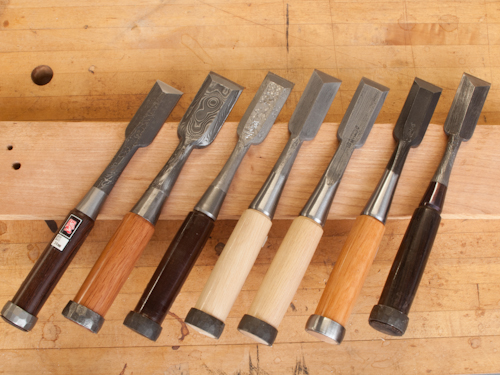 In the European tradition the steel parts of tools have been usually made, for the last couple of centuries anyway, in large factories. The metalwork is usually straightforward, forged by nameless smiths, and any decorative differentiation is in the handle material, and maybe some brass trim. In Japan where the manufacture of edge tools is still concentrated in the hands of masters who sign their work, most chisel makers have one or two decorative versions of their tools where the steel itself is the focus of the decorations. In the European tradition the steel parts of tools have been usually made, for the last couple of centuries anyway, in large factories. The metalwork is usually straightforward, forged by nameless smiths, and any decorative differentiation is in the handle material, and maybe some brass trim. In Japan where the manufacture of edge tools is still concentrated in the hands of masters who sign their work, most chisel makers have one or two decorative versions of their tools where the steel itself is the focus of the decorations.
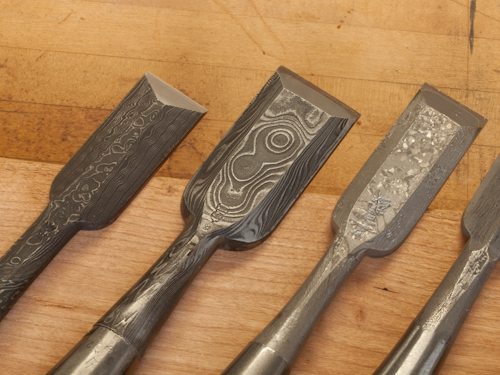 In Japanese practice a thin high carbon steel cutting edge is forge welded onto a soft steel body. It's the body where the decorative moves take place. As all the tools by a specific maker have the same cutting edge layer there is no functional reason to use a decorative chisel. But they look cool, are eminently collectible, and in many cases inspire one to do better work. In Japanese practice a thin high carbon steel cutting edge is forge welded onto a soft steel body. It's the body where the decorative moves take place. As all the tools by a specific maker have the same cutting edge layer there is no functional reason to use a decorative chisel. But they look cool, are eminently collectible, and in many cases inspire one to do better work.
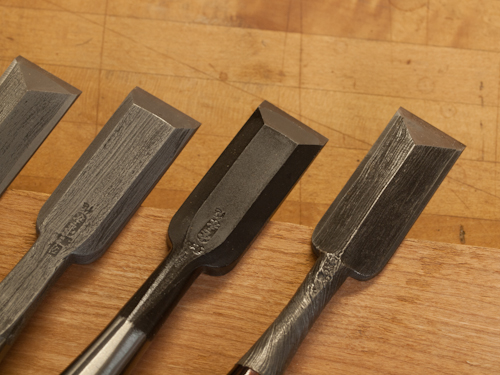 I don't actually collect decorative chisels so the pieces I have in my collection date from the early days of this company when we imported samples of Japanese tools. I don't actually collect decorative chisels so the pieces I have in my collection date from the early days of this company when we imported samples of Japanese tools.
From the left (in the top picture and the first detail shot) three suminagashi style chisels, starting from the left, by Tasai. Then comes an maker I don't recall, followed by a chisel by Iyoroi. The suminagashi style is made by welding two different kinds of iron and other metals together, then flattening,folding and rewelding the resultant billet. The English term for suminagashi is "Damascus steel". Finally the steel is etched to bring out the dissimilar layers in a visible pattern. By varying the folds, layers, and materials you can get different patterns. Tasai is considered the modern master of this technique and you can see how elegant and reserved his chisels can be. The chisel by Iyoroi is fairly recent. The father of the current Iyori did spectacular suminagashi work but on his retirement the skill was not passed on and this new interpretation, while interesting, doesn't really excite me. I don't know much about the maker in the middle, the over the top character of the layers suggests that some of the decoration might have been formed not by folding but by welding already punched steel into layer. I just don't know enough to be sure.
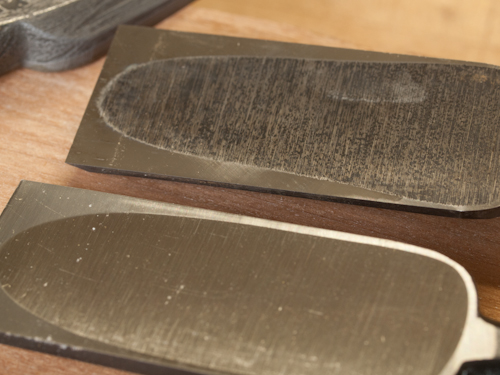 In the second detail picture (and on the right of the main picture) we have a plain chisel in the middle surrounded by two chisels made from kamaji iron. The chisel on the right is by Nishiki and has a twisted shank - an old style which Nishiki reintroduced. (As far as we know Nishiki is retired and we only have a limited amount of his non-decorative chisels available) This style is make by using kamaji iron - which is very old wrought iron from before 1850, before sulfurous coals were used in the refinement, for the body of the chisel. After welding the body to the bottom steel layer the kamaji iron is etched. Wrought iron has lots of impurities, and is also was originally formed formed by forging, so after etching the impurities away you get a tree bark like texture which is very elegant. In the second detail picture (and on the right of the main picture) we have a plain chisel in the middle surrounded by two chisels made from kamaji iron. The chisel on the right is by Nishiki and has a twisted shank - an old style which Nishiki reintroduced. (As far as we know Nishiki is retired and we only have a limited amount of his non-decorative chisels available) This style is make by using kamaji iron - which is very old wrought iron from before 1850, before sulfurous coals were used in the refinement, for the body of the chisel. After welding the body to the bottom steel layer the kamaji iron is etched. Wrought iron has lots of impurities, and is also was originally formed formed by forging, so after etching the impurities away you get a tree bark like texture which is very elegant.
One important characteristic of Japanese chisels is that they have hollow backs. The hollow is usually ground in, but it also can get decorative treatment. Nishiki chemically accentuates the grind texture, some other makers try for a smooth dead matte surface.
While I plan an additional blog entry on decorative handles and hoops in the near future here are a few more pictures, showing some of the decorative details of the suminagashi chisels and a closeup of the twisted neck chisel by Nishiki.
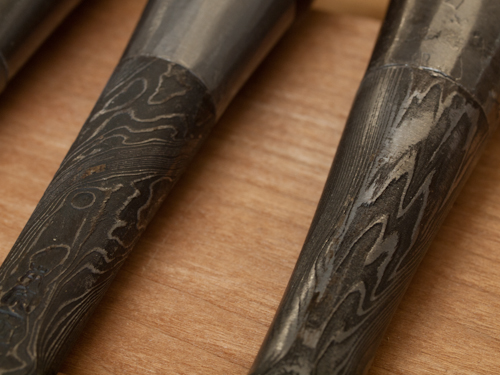
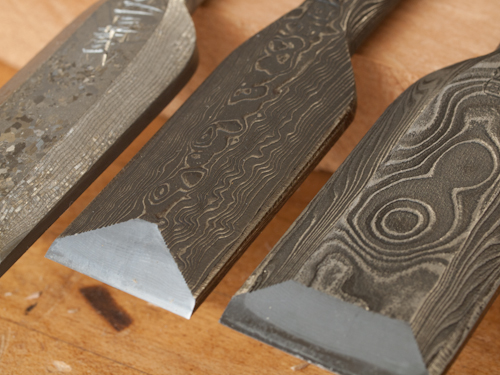
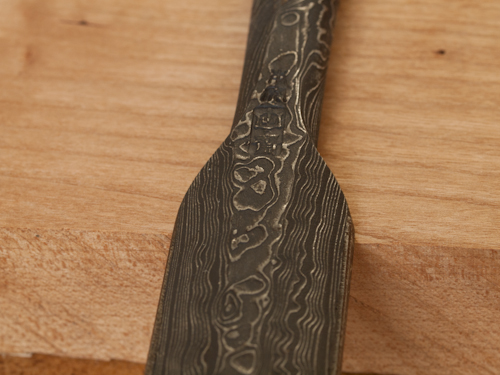
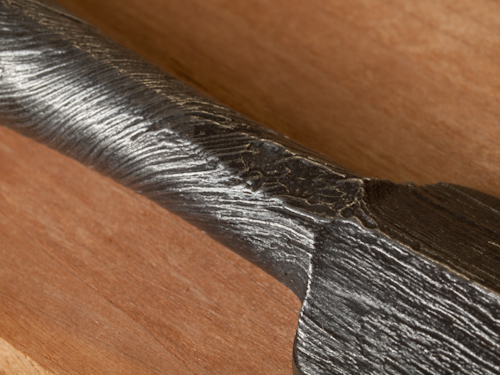 |
Join the conversation |
|
 Joel's Blog
Joel's Blog Built-It Blog
Built-It Blog Video Roundup
Video Roundup Classes & Events
Classes & Events Work Magazine
Work Magazine


 In the European tradition the steel parts of tools have been usually made, for the last couple of centuries anyway, in large factories. The metalwork is usually straightforward, forged by nameless smiths, and any decorative differentiation is in the handle material, and maybe some brass trim. In Japan where the manufacture of edge tools is still concentrated in the hands of masters who sign their work, most chisel makers have one or two decorative versions of their tools where the steel itself is the focus of the decorations.
In the European tradition the steel parts of tools have been usually made, for the last couple of centuries anyway, in large factories. The metalwork is usually straightforward, forged by nameless smiths, and any decorative differentiation is in the handle material, and maybe some brass trim. In Japan where the manufacture of edge tools is still concentrated in the hands of masters who sign their work, most chisel makers have one or two decorative versions of their tools where the steel itself is the focus of the decorations.  In Japanese practice a thin high carbon steel cutting edge is forge welded onto a soft steel body. It's the body where the decorative moves take place. As all the tools by a specific maker have the same cutting edge layer there is no functional reason to use a decorative chisel. But they look cool, are eminently collectible, and in many cases inspire one to do better work.
In Japanese practice a thin high carbon steel cutting edge is forge welded onto a soft steel body. It's the body where the decorative moves take place. As all the tools by a specific maker have the same cutting edge layer there is no functional reason to use a decorative chisel. But they look cool, are eminently collectible, and in many cases inspire one to do better work.  I don't actually collect decorative chisels so the pieces I have in my collection date from the early days of this company when we imported samples of Japanese tools.
I don't actually collect decorative chisels so the pieces I have in my collection date from the early days of this company when we imported samples of Japanese tools. In the second detail picture (and on the right of the main picture) we have a plain chisel in the middle surrounded by two chisels made from kamaji iron. The chisel on the right is by Nishiki and has a twisted shank - an old style which Nishiki reintroduced. (As far as we know Nishiki is retired and we only have
In the second detail picture (and on the right of the main picture) we have a plain chisel in the middle surrounded by two chisels made from kamaji iron. The chisel on the right is by Nishiki and has a twisted shank - an old style which Nishiki reintroduced. (As far as we know Nishiki is retired and we only have 



Aloha
Walter